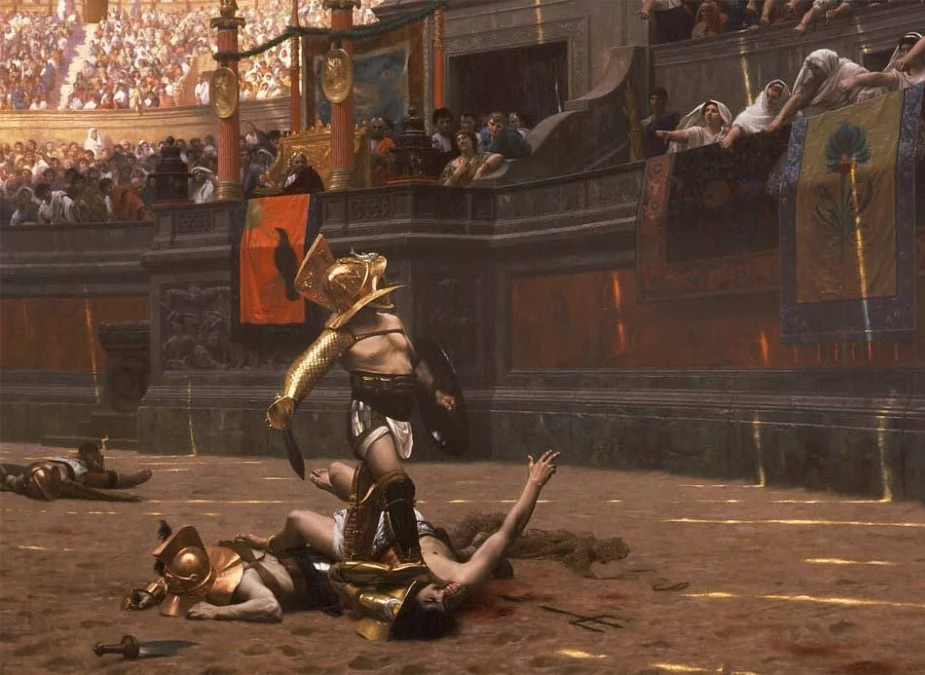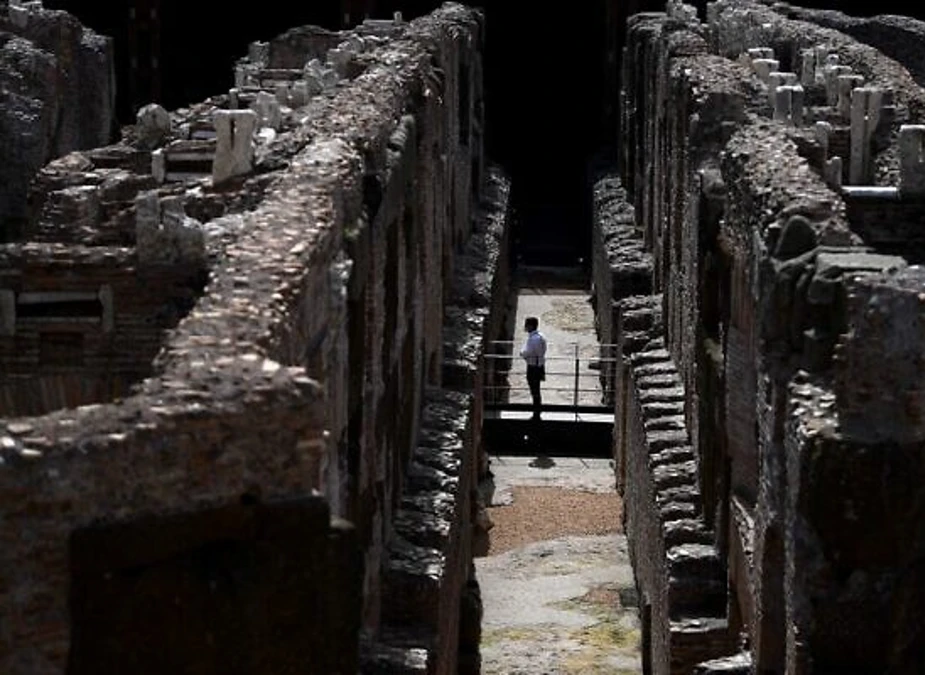Did you know the Colosseum in Rome is nearly 2,000 years old and could hold up to 80,000 spectators? As one of the largest amphitheaters ever built, it wasn’t just a venue for gladiatorial combat and exotic animal fights. It was a stage for various spectacles that entertained Roman citizens. But what happened in the center of the Colosseum you see in movies that made it the heart of Roman entertainment?
Let’s explore the history and secrets of this ancient arena!
Types of Events
The events that took place in the Colosseum showcased the power and wealth of the Roman Empire. Here is a peek at the various kinds of events that were held in this magnificent arena:
Gladiatorial Games

Gladiators, often slaves or prisoners of war, fought in intense battles. These warriors were trained to engage in duels and group fights, keeping the crowd on the edge of their seats. There were different types of gladiators, each with unique armor and weapons. For example, the Murmillo carried a large shield and wore a helmet with a fish-shaped crest, while the Retiarius used a net and trident.
Gladiator Information
Spartacus, a Thracian gladiator from the first century BC, is one of the most famous gladiators in history. He was a brilliant fighter and a commander who spearheaded a major slave insurrection that shook the Roman Republic to its core. Though the uprising was ultimately crushed, Spartacus’ story inspires us today.
Animal Hunts
The arena hosted dramatic hunts featuring exotic animals like lions, tigers, elephants, and bears. These animals were brought in from the far corners of the empire, showcasing Rome’s vast reach. Professional hunters, and sometimes even condemned criminals, faced these wild beasts in deadly encounters that demonstrated human dominance over nature.
Public Executions

One of the most brutal forms of execution involved criminals being killed by wild animals. This was a public display meant to serve as both a punishment and a deterrent. Executions also included burning at the stake, crucifixion, or forced combat against armed gladiators. These were gruesome spectacles that the audience watched with morbid fascination.
Mythological Dramas
The Colosseum also hosted dramatic performances based on Roman mythology. These productions featured elaborate sets, costumes, and sometimes real bloodshed when actors portrayed mythological figures meeting violent ends.
Mock Naval Battles (Naumachiae)
The Colosseum’s floor was flooded to create a temporary lake for mock sea battles, known as naumachiae. Ingenious engineering brought water into the arena for these impressive spectacles. These battles reenacted famous naval encounters, complete with real ships and combatants, demonstrating Rome’s engineering prowess and military might.
Construction and Architecture
The Colosseum, also known as the Flavian Amphitheatre, is an architectural masterpiece that demonstrates the brilliance of ancient Roman engineers. Here are some noteworthy details regarding its construction and architecture:
Who Built It?
The Colosseum’s construction began in AD 72 under Emperor Vespasian, who was focused on rebuilding Rome after a destructive civil war. He envisioned the Colosseum as a gift to the people, a place of entertainment, and a symbol of the empire’s newfound stability.
Vespasian did not live to see it completed, but his sons, Titus and Domitian, continued the work. Titus oversaw the grand opening in 80 AD, which included 100 days of celebratory games, while Domitian added the top tier of seating to accommodate the ever-growing crowds.
Building Materials and Labour Force
The Amphitheater was primarily constructed using travertine limestone for the outer walls, tuff (volcanic rock) for the inner walls, and concrete for the foundations and arches. The construction required tens of thousands of laborers, including skilled artisans and a large contingent of slaves, many of whom were prisoners captured during Rome’s military campaigns.
This workforce labored tirelessly under the direction of skilled architects and engineers to complete the Colosseum within about eight years.
Arches and Vaults
The Colosseum’s 80 entrance arches on the ground level allowed for efficient crowd management. These arches supported the structure’s massive weight and facilitated spectators’ efficient movement into and out of the arena. Inside, a complex system of groin vaults provided strength and stability, allowing the Colosseum to span such a large area without needing internal pillars.
Hypogeum

The hypogeum is an underground network of tunnels and chambers that was crucial to the arena’s functionality. Before their performances, gladiators and wild animals were held in cells and cages within the hypogeum, which allowed for dramatic entrances into the arena via lifts and trapdoors.
The hypogeum also contained the mechanisms for elevators and pulleys that lifted performers, animals, and props onto the arena floor. This included the intricate machinery required to stage elaborate spectacles such as mock sea battles (naumachiae).
Step into the wonders of Colosseum!
Turn your curiosity into an adventure with our world-trusted partners.
Hierarchy of Seating
The Colosseum’s seating reflected Roman society, with meticulously planned tiers placing spectators based on their social rank.
VIP People
The seating tiers were divided into distinct sections based on social status. The most prestigious seats, closest to the arena floor, were reserved for the elite class, including senators, magistrates, and other dignitaries. These seats provided the best views of the action and were adorned with marble and other luxurious materials.
Common Citizens
The middle tiers were for the average Roman citizen. The seats were not as fancy as the VIP section, but they provided decent views of the events below. The seating arrangements for the general public were organized by social standing and proximity to the arena.
Women and Lower Classes
The uppermost tier, the summa cavea, was reserved for women and the lower classes of Roman society. The seating here was more basic, consisting of wooden benches or standing room, and provided a more distant view of the arena.
Myths and Legends
The Colosseum has accumulated myths that have added to its mystique over the years. According to legend, a curse was cast upon the monument due to the extreme violence witnessed within its walls, which is said to be the reason for parts of the monument collapsing over time.
During the Middle Ages, another intriguing belief emerged—that the Colosseum served as one of the seven gates to the underworld. This idea likely came from the arena’s association with death and the brutal games held there, making it seem like a portal to realms beyond the living.
Fun Facts about the Colosseum!
- The monument has been a backdrop for many movies, from the epic battles of ‘Gladiator’ to Audrey Hepburn’s Roman adventure in ‘Roman Holiday.’
- The Colosseum, originally known as the Flavian Amphitheatre, was named after the emperors of the Flavian dynasty who built it.
- Historians believe that ivory fragments discovered in the ruins of the Colosseum suggest that the ancient Romans used them as symbolic ornaments.
- During the Middle Ages, the Colosseum became a popular spot for Christian martyrs.
- Historical evidence reveals the existence of gladiatrices — women who trained and fought as gladiators alongside their male counterparts
- Spectators at the Colosseum were so captivated by the events that some took home pieces of broken pottery or sand from the arena floor as souvenirs.
FAQs
1. How many gladiators died in the Colosseum?
It’s difficult to pinpoint the exact number, but historians estimate that around 400,000 people, including gladiators, slaves, convicts, prisoners, and other performers, died in the Colosseum during its roughly 350 years of hosting violent spectacles and events.
2. How many people visit the Colosseum annually?
The Amphitheater is one of the most visited tourist attractions in the world. On average, it receives over seven million visitors annually.
3. How big is the Colosseum?
The Colosseum is one of the largest amphitheaters ever built, capable of seating between 50,000 to 80,000 spectators. It covers an area of about 6 acres (24,000 square meters).
4. What happened to the Colosseum after the fall of Rome?
After the decline of the Roman Empire, the Colosseum fell into disrepair and was subjected to looting and natural disasters. It was later repurposed for various uses, including housing, workshops, and defensive fortifications during the medieval period.
5. Can you visit the Colosseum today?
Yes, the Colosseum is open to visitors as a major tourist attraction in Rome. With a basic Colosseum entry ticket, you can explore the interior of the amphitheater, including the arena floor and the underground tunnels.
Featured Image: Unsplash.com



